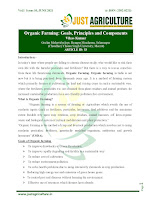Fundamental
Processes are:-
(1). Humification:- Humification is the
process of transformation (decomposition) of raw organic matter in to ‘HUMUS’.
It is an extremely complex process involving various organisms such as
bacteria, fungi, actinomycetes, earth worms and termites.
(3). Illuviation:- The process of deposition of soil materials (removed from the elluvial horizon “E”) in the lower layer is termed as “illuviation”. The horizons formed by this process are termed as illuvial horizons (B-horizon especially).
(4). Horizonation:-
The
development of all the horizons in soil is termed as horizonation. In the
favorable conditions it take about 250 years but in adverse conditions take
even 1000 years.
Specific Pedogenic Processes. (a). Zonal Pedogenic processes:-
(1). Calcification:-
The
process of precipitation and accumulation of calcium carbonate in some part of
the profile is called calcification. This is a common process in arid and
semi-arid regions, which are low in rainfall.
The illuviated horizon of
CaCO3 is designated as ‘calcic horizon’.
This occurs mostly in
high rainfall or humid regions.
(3). Podzolization:- ( Russian term) Pod = under and zola = ash like. It is a process of soil formation resulting in the formation of podzols and podzolic soils. It is the process of accumulation of silica and eluviation of sesquioxides. The podzols soils are low in fertility and mainly used for forestry and pastures.
(4). Laterization:- The term laterite is derived from the word “later” means “brick” or “tile”. This soil forming process is called “laterization” or “Lotozation” Eg: Soils of Malabar hills of Kerala. In laterization, silica is removed leaving sesquioxides to remain in solum. Favourable conditions are warm and humid climate. this type of soil mainly used for shifting cultivation, growing plantation crops.
(b). Intrazonal
Processes:-
(5). Gleization:- “Glei” means blue, grey or green clay. The gleization is a process of soil formation resulting in the development of a glei (or gley) horizon in the lower part of the profile above the parent material due to poor drainage conditions or water logged conditions. Such soils are called “hydromorphic soils”.
(6). Salination:- It is the process of accumulation of salts such as sulphates, chlorides of calcium, magnesium, sodium and potassium in soils in the form of salty (salic) horizon. The soils are called saline soils, which have ESP less than 15% and pH between 7 and 8.5.
(7). Solonization/Alkalization:-
The
process involves the accumulation of sodium ions on the exchange complex of the
clay, resulting in the formation of sodic soils (solonetz) under arid and
semi-arid conditions. This occurs when anions like carbonates and bicarbonates
predominate in soil.
(8). Solodization/Dealakilzation:-
This
process refers to the removal of Na+ from exchange sites. The Na+ can be eliminated by increasing the
concentration of Ca2+ or Mg2+ in the water, followed by
improved drainage facilities.
(9). Pedoturbation:- It is the process of mixing of the soils. Mixing to some extent takes place in all soils.
(1). Faunal pedoturbation:-
Mixing
by animals such as ants, earthworms,
moles, rodents and man himself.
(2). Floral pedoturbation:-
Mixing
by plants, as in tree tipping that forms pits and mounds.
(3). Argillopedoturbation:- Mixing of materials in solum by churning process caused by swell - shrink clays as is observed in deep black cotton soil.
Note:- All the pictures included in the blog have been taken from the various internet sources. All the right of the pictures are secured to their owners. Pictures are only used here for the fair use of content for educatioal purpose.



















0 Comments